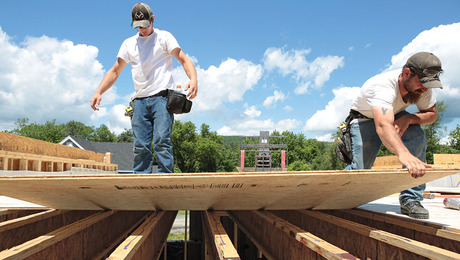I am looking for advice on insulation under concrete slab that contains radiant heat.The plans call out for 2 inches of rigid foam board(r-10) This I am familiar with and seems to work.I recently saw an add for a material that was blancket like(very thin and rool out like plasic vapor barrior)The add says it is equal or better that rigid foam.Anyone have thoughts or experience?
Discussion Forum
Discussion Forum
Up Next
Video Shorts
Featured Story

For a stable, flat, and squeak-free floor, you'll find that most new products are OSB.
Featured Video
How to Install Cable Rail Around Wood-Post CornersHighlights
"I have learned so much thanks to the searchable articles on the FHB website. I can confidently say that I expect to be a life-long subscriber." - M.K.

















Replies
There's no way to get R-10 from a film in an underslab situation. Better to stick with what 99% of the industry is using and simply use foam.
Others with more energy might go into why those inflated R-value claims don't hold water in applications like this.
Best of luck.
Beer was created so carpenters wouldn't rule the world.
Insulating the edges is as important as insulating under.
Forget the blanket. You ned the 2" of foam - make sure that it is closed cell EPS or XPS
Welcome to the
Taunton University of Knowledge FHB Campus at Breaktime.
where ...
Excellence is its own reward!
I did the same floor several years ago. If the blanket that you describe is double bubble (like wrapping for a fragile package) with one foil face, then I say add it under the ridged foam with the foil face up. I didn't on the advice of the "pro's" and now regret it. Remember your dealing with radiant heat. The ridged foam will help greatly with the cold from the ground being telegraphed to the slab via conduction but it will not help reflect the radiant heat back up into the room where you want it. Radiant heat goes right through congenital insulation but is reflected back into the room by a substance like aluminum foil. Take a sheet of foil out into the sun and feel the heat reflected back on your face. The same goes for the walls. If possible somewhere in the structure add a foil face. Polyisocynide board with a foil face works wonders at keeping the cold out and the radiant heat in. As suggested before, be sure to detail the edge of the foundation also.
Reflective barriers have to have an air space. No air space under concrete. No manufacturer can give you an r-value for reflective insulation under concrete.
" congenital insulation"Congenital????"congenitalMain Entry:
con·gen·i·tal Listen to the pronunciation of congenital
Pronunciation:
kən-ˈje-nə-təl, kän-
Function:
adjective
Etymology:
Latin congenitus, from com- + genitus, past participle of gignere to bring forth — more at kin
Date:
17961 a: existing at or dating from birth <congenital deafness> b: constituting an essential characteristic : inherent <congenital fear of snakes> c: acquired during development in the uterus and not through heredity <congenital syphilis>2: being such by nature <a congenital liar>""Radiant heat goes right through congenital insulation but is reflected back into the room by a substance like aluminum foil. Take a sheet of foil out into the sun and feel the heat reflected back on your face. The same goes for the walls. If possible somewhere in the structure add a foil face. Polyisocynide board with a foil face works wonders at keeping the cold out and the radiant heat in."There is no radiant heat IN THE SLAB.The hot water is the tubing CONDUCTS heat to the concrete. And from the concrete it CONDUCTS heat to the finished surface. Heat also tries to conduct into the ground. "Massive" insulation is used below the slab to reduce the conduction of heat into the ground. At this point radiation does not have anything to do with it.An aluminum foil in direct contact with a heated surface is a GREAT CONDUTOR OF HEAT.Let try it. Put a piece of foil directly over a stove burner and turn the burn on. Then place your hand on the other side of the foil. The burn on your hand is caused by conducted heat.The heat in the tubing CONDUCTS to heat the concrete, which inturn CONDUCTS heat to heat the finished flooring.The finished floor then heats the room and contents via RADIATION and CONVECTION..
.
A-holes. Hey every group has to have one. And I have been elected to be the one. I should make that my tagline.
Foil faced radiant barriers only work when an ich of air space is desined in from of them. Even most of the manufacturers sites admit that, though it is often in the fine print.The bubble wrap foild gives no more insulation than the 1/4" of dead air locked inside - about what a window has between panes - not much! It is only in ideal laboratory conditions that it performs as claimed in some ads. I doubt it EVER performs that way on site but definitely not under concrete.
Welcome to the Taunton University of Knowledge FHB Campus at Breaktime. where ... Excellence is its own reward!
TwoThumbs,
Several of your statements are false. It sounds like you were ill-informed by the same fraudsters who sold you worthless bubble wrap to install under your slab.
Your wrote: "Remember you're dealing with radiant heat. The ridgid foam will help greatly with the cold from the ground being telegraphed to the slab via conduction but it will not help reflect the radiant heat back up into the room where you want it. Radiant heat goes right through conventional insulation but is reflected back into the room by a substance like aluminum foil." In fact, the transfer of heat to the soil below is entirely a matter of conduction, not radiation. Radiant heat does not "go right through conventional insulation." Radiant heat is a type of heat transfer that occurs through air or a vacuum. If a slab-on-grade is warm, it can radiate heat upward through the air but it cannot radiate heat downward to the ground. It can conduct heat downward, however. Obviously, rigid foam is the way to go.
Finally, remember that aluminum foil is an excellent conductor. It is not an insulator. If you put it under a slab, it will simply help conduct the heat away from the slab.
The claims of aluminized bubble wrap have been exposed as fraud, and the manufacturer is in legal trouble. Use the 2" rigid foam, and like someone else said, isolate the perimeter also. For the perimeter all you need is ½", just enough to form a thermal break.
Don't know anything about the bubble wrap...
A few thoughts about rigid foam. Foam comes in different compressive strengths as expressed in PSI ratings. Also, if you are in a geographid area with termites, you may want to consider using a borate treated foam.